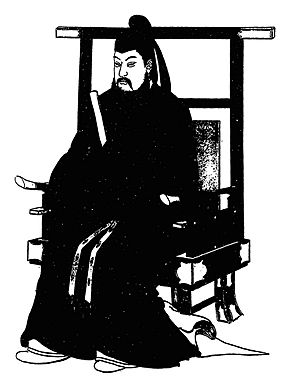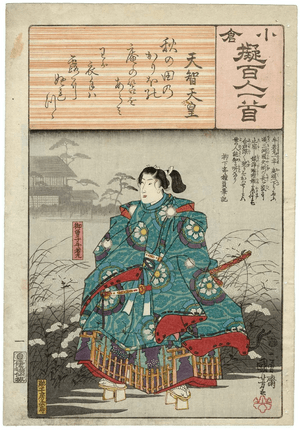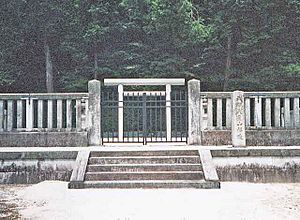Emperor Tenji facts for kids
Quick facts for kids Emperor Tenji天智天皇 |
|||||
|---|---|---|---|---|---|
 |
|||||
| Emperor of Japan | |||||
| Reign | 661–672 | ||||
| Predecessor | Saimei | ||||
| Successor | Kōbun | ||||
| Born | Kazuraki (葛城) 626 |
||||
| Died | January 7, 672 (aged 45–46) Ōmi no Miya (Shiga) |
||||
| Burial | Yamashina no misasagi (山科陵) (Kyoto) | ||||
| Spouse | Yamato Hime no Ōkimi | ||||
| Issue among others... |
|
||||
|
|||||
| House | Yamato | ||||
| Father | Emperor Jomei | ||||
| Mother | Empress Kōgyoku | ||||
Emperor Tenji (天智天皇 (Tenji-tennō)) was the 38th Emperor of Japan. He was born in 626 and passed away on January 7, 672. Before becoming emperor, he was known as Prince Katsuragi and later Prince Nakano Ōe. He ruled from 668 to 671.
Emperor Tenji was the son of Emperor Jomei and Empress Kōgyoku (who was also known as Empress Saimei). Some of his famous children included Empress Jitō, Empress Genmei, and Emperor Kōbun.
In 645, while still a prince, Tenji worked with Fujiwara no Kamatari to defeat the powerful Soga clan. This led to big political changes in Japan. He became the crown prince and held real power. Even though his mother, Empress Saimei, died, he waited seven years to officially become emperor. He moved the capital to Ōmi in 668. He also created Japan's first family register, called the Kōgo Nenjaku, and the first set of laws, known as the Ōmi Code.
Contents
Emperor Tenji's Early Life
Emperor Tenji was the son of Emperor Jomei. His mother, Empress Saimei, ruled before him. Before he became emperor, he was known as Prince Naka-no-Ōe (中大兄皇子, Naka-no-Ōe no Ōji).
Ending the Soga Clan's Power
As a prince, Naka-no-Ōe played a very important role. He helped stop the Soga clan from having too much control over the imperial family. In 644, he saw that the Soga clan was still gaining power. So, he planned with Nakatomi no Kamatari and Soga no Kurayamada no Ishikawa no Maro to assassinate Soga no Iruka. This event is known as the Isshi Incident.
After the Isshi Incident, Iruka's supporters quickly scattered. Prince Naka-no-Ōe was then named the next in line to the throne. He also married the daughter of his ally, Soga no Kurayamada. This helped ensure that a large part of the Soga clan's power was now on his side.
Key Events During Tenji's Reign
Naka-no-Ōe ruled as Emperor Tenji from 661 to 672.
- 661: In the third year of Empress Saimei's rule, she named her son as her heir. This meant he would take over after her death. Soon after, she died, and Emperor Tenji officially became emperor.
- 662: Tenji is believed to have created Japan's first legal code. This code, called the Ōmi Code, had 22 volumes. It was put into effect in the last year of his reign. This original code no longer exists. However, it was later improved in the Asuka Kiyomihara ritsu-ryō of 689. These laws were a step towards the more famous Taihō ritsu-ryō of 701.
- 663: Emperor Tenji sent an army to Korea. He wanted to help Japan's ally, Paekche, one of Korea's Three Kingdoms. Paekche had been taken over by the Korean kingdom of Silla in 660. However, Tenji's forces were badly defeated at the Battle of Baekgang by the combined armies of Silla and Tang China.
- 668: The Nihon Shoki, an ancient Japanese history book, mentions oil for the first time in Japan. In the seventh year of Tenji's reign, "flammable water" (which was probably petroleum) was given to Emperor Tenji. This came from Echigo Province (now part of Niigata Prefecture). This gift happened when the emperor was officially confirmed as emperor. He had waited to hold this ceremony until his mother's tomb was finished. Once it was done, he could no longer delay. Until this time, he had been the actual ruler but still held the title of Crown Prince.
- 671: The Nihon Shoki also mentions the first public announcement of time in Japan. This was done using a rōkoku, which was a type of water clock. There is also a mention of this kind of clock in 660.
Emperor Tenji worked hard to improve the military. He built upon the military systems that were set up during the Taika Reforms.
The Emperor's Passing
After Emperor Tenji died in 672, there was a disagreement over who should rule next. He had fourteen children, many from different mothers. In the end, his son, Prince Ōtomo, became Emperor Kōbun. Then, Tenji's brother, Prince Ōama, became Emperor Tenmu. Almost a hundred years after Tenji's death, the throne went to his grandson, Emperor Kōnin.
The exact place where Tenji is buried is known. This emperor is traditionally honored at a memorial Shinto shrine called a misasagi. It is located in Yamashina-ku, Kyoto. The Imperial Household Agency officially calls this place Yamashina no misasagi.
Poetry by Emperor Tenji
The Man'yōshū is an old collection of Japanese poems. It includes poems said to be written by emperors and empresses. One poem, "The Three Hills," is thought to have been written by Emperor Tenji. He wrote it when he was still Crown Prince during his mother Empress Saimei's reign.
| Japanese | Rōmaji | English |
|
香具山は |
Kaguyama wa |
Mount Kagu strove with |
Another one of his poems was chosen by Fujiwara no Teika. It is the first poem in the very popular Hyakunin Isshu anthology.
| Japanese | Rōmaji | English |
|
秋の田の |
Aki no ta no |
Because of the coarseness of the rush-mat |
After he died, his wife, Empress Yamato, wrote a song about how much she missed him.
Important Court Officials
The most important court officials (公卿, Kugyō) during Emperor Tenji's time included:
- Daijō-daijin: Ōtomo no Ōji (大友皇子), from 671 to 672.
- Naishin (内臣): Fujiwara no Kamatari (藤原鎌足) (614–669), from 645 to 669.
Prince Ōtomo (Ōtomo-shinnō) was Emperor Tenji's favorite son. He was also the first person to be given the important title of Daijō-daijin.
Consorts and Children
Emperor Tenji had many consorts and children. Here are some of them:
- Empress: Yamato Hime no Ōkimi, daughter of Prince Furuhito-no-Ōe.
- Hin: Soga no Ochi-no-iratsume (died around 651), daughter of Soga no Kura-no-yamada no Ishikawa-no-maro.
- First Daughter: Princess Ōta, who married Emperor Tenmu.
- Second Daughter: Princess Uno-no-sarara, who later became Empress Jitō.
- Second Son: Prince Takeru (651–658).
- Hin: Soga no Mei-no-iratsume, daughter of Soga no Kura-no-yamada no Ishikawa-no-maro.
- Third Daughter: Princess Minabe, who married Prince Takechi.
- Fourth Daughter: Princess Abe/Ahe, who later became Empress Genmei, and married Prince Kusakabe.
- Hin: Soga no Hitachi-no-iratsume, daughter of Soga no Akae.
- Princess Yamabe, who married Prince Ōtsu.
- Hin: Abe no Tachibana-no-iratsume (died 681), daughter of Abe no Kurahashi-maro.
- Princess Asuka, who married Prince Osakabe.
- Princess Niitabe, who married Emperor Tenmu.
- 10th son: Prince Ōama, who later became Emperor Tenmu.
- Court lady: Koshi-no-michi no Iratsume.
- Seventh Son: Prince Shiki (died 716), who was the father of Emperor Kōnin.
- Court lady (Uneme): Yakako-no-iratsume, from Iga.
- First Son: Prince Ōtomo, who later became Emperor Kōbun.
- Prince Abe (born 648).
- Princess Aga (648-709).
- Court lady: Oshinumi no Shikibuko-no-iratsume, daughter of Oshinumi Zokuryu.
- Third Son: Prince Kawashima (657–691).
- Princess Ōe, who married Emperor Tenmu.
- Princess Izumi, who was a Saiō at Ise Shrine (701–706).
- Court lady: Kurikuma no Kurohime-no-iratsume, daughter of Kurikuma Tokuman.
- Princess Minushi.
In Popular Culture
- Emperor Tenji was played by Ahn Hong-jin in the 2012-2013 KBS1 TV series Dream of the Emperor.
See also
 In Spanish: Tenji Tennō para niños
In Spanish: Tenji Tennō para niños
- Emperor of Japan
- List of Emperors of Japan
- Omi Shrine



